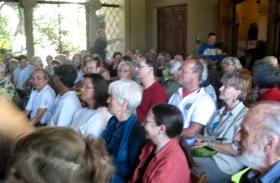Festivals, unlike single concerts, are full-immersion events with lots of possibilities to explore all at once. In an effort to bring the festival experience closer to our readers, SFCV sent two writers — Jonathan Rhodes Lee, an experienced early-music performer and writer, and Jessica Hilo, an arts writer with less connection to the early-music world — to “blog” for a full day (last Saturday) at the Berkeley Festival. One master class, two concerts, and one exhibition later, enervated by the day’s oppressive heat, they filed this report.
Scoping Things Out (Jessica)
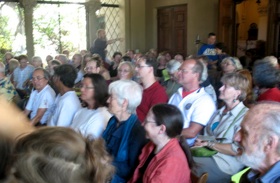
Concert attendees flocked to the Berkeley Festival and Exhibition’s 60 Fringe events in droves — a welcome development for SFEMS, whose newness to festival organization and the year’s depleted funding motivated a turn toward community-based programming. Although attendance statistics have yet to be tabulated, SFEMS Executive Director Harvey Malloy claimed that most Fringe concerts had been at virtually full capacity: “They have been extremely well-received ... they’ve been filling the house every night.
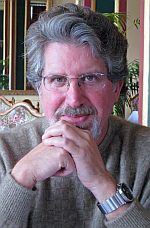
“The concept of the festival as we conceived it,” Malloy explained, “[encouraged] a lot of equal participation from the community.” While SFEMS served as this year’s clearinghouse for festival promotion, most Fringe concerts were self-produced. Artists provided their own box office, ticket pricing, program books, and venue space.
Although the collaboration with partner arts ensembles formed the cornerstone for Fringe concert success, Malloy avoided comment on the scope and strategy of future festivals. “I think it’s premature to say, at the moment. Every festival we have brings up early music,” he explained, “[but] there will be a festival in 2012.”
Ralph Berberch, a SFEMS member and longtime patron of the Philharmonia Baroque Orchestra, circled the festival’s exhibition room. Dazed from his two-week post as an on-call volunteer, one of the 80 members whose responsibilities ran the gamut from feeding musicians to moving instruments, Berberch regrets he could not attend many of the festival’s Fringe events. Of the sole festival event he had attended, last week’s Galax Quartet concert of Bach’s Art of Fugue, Berberch unfalteringly said, “It’s great to hear such devoted musicians playing [this] incredible music.”
“I’ll make it up!” Berberch promised as he continued his on-call duties — and winked knowingly.
Oh, So French (Jonathan)
12:15 p.m.: I was thrilled when SFCV asked me to do a “pub crawl” of the events on one day of Berkeley’s biennial early-music festival. On odd-numbered years a parallel festival is mounted in Boston, which tends to be a bigger production, with a full-scale staged opera as part of its grand finale. But the Berkeley festival has real charm, with a full slate of concerts, usually sponsored by Cal Performances, and an even fuller roster of concerts lurking around the “fringe” of the main stage.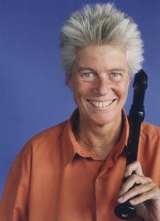
There’s a good general rule with pub crawls: Start early. And there’s nothing to start the day like a morning snifter of brandy — or, in this case, a snifter of Armagnac, that famously rare libation from the south of France. I started with just that, in musical terms, hearing local recorder player Tish Berlin perform a sarabande by Hotteterre titled La d’Armagnac. The venue was a master class given by an internationally renowned virtuoso, Marion Verbruggen. A perennial favorite in the Bay Area, Verbruggen comes here virtually every year to preside over the San Francisco Early Music Society’s summer workshops. Although I’ve heard her play many times, I’ve never seen her give a master class, and so I was really interested to watch the dynamic that she maintained with Berlin and the other participants. She treated them all with the utmost respect. Berlin is a local recorder teacher and well-seasoned performer. The second participant whom I heard, Andrew Levy, is a younger player, but one of no less professional caliber. So, Verbruggen didn’t actually end up with too much to coach, technically speaking. What more is there to say when there are no dropped notes, tempos are perfect, and everything is in good tune?
Well, I can say that since Verbruggen is one of the undisputed master interpreters of Baroque music, she found plenty to say to both these gifted players about style and ornamentation. The two pieces that the students played were firmly in the French Baroque style, famous for its difficult ornaments and perplexing melodic phrasing. Verbruggen focused on these elements of interpretation, advising the players at the micro level, down to instructing exactly which 16th-note division of a beat should be the beginning of a particularly thorny type of trill.
Throughout all this advice, Verbruggen proved herself amazingly adept at creating quotable aphorisms. I started jotting down these instant sound bites as she coached, and include here just a few of my favorites:
(To Tish Berlin): French music is just ... well, it’s just trills. And it can be really boring if you don’t know what to do with them. (To Barbara Krumdiek, cellist who accompanied Tish Berlin): Don’t try to be the ideal continuo player. Such a thing doesn’t exist. (To Andrew Levy): I know that Bach was a Protestant, but come on! He also liked to party. Stop sounding so North German!Well, that was fun. Now, I’m off to lunch at the Musical Offering [café on Bancroft Avenue]. Where else would you go for lunch during an early-music festival, except to a café that plays (and sells) early-music CDs, and where the food counter is in the shape of a harpsichord?
Naughtiness Needs Encouragement (Jessica)
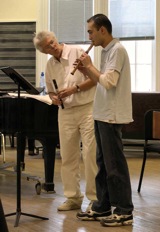 Indomitably funny, sprightly, and at times extraordinarily bombastic for such a small woman, Marion Verbruggen presented a recorder master class that was educational and entertaining for trained musicians and aficionados alike.
Indomitably funny, sprightly, and at times extraordinarily bombastic for such a small woman, Marion Verbruggen presented a recorder master class that was educational and entertaining for trained musicians and aficionados alike. Part of the charm of her class was watching the precision with which she elicited and critiqued her students’ performances — teasing out ornamental and lively readings of music that’s often boring and static. Navigating the space wrought from Verbruggen’s encouragement, students seemed freed, and performances were transformed like trepidatious cats — stretching and breathing in their newfound freedom.
While there’s something nice in a deep, expressionistic reading of music whose lofty reputation often distances its listener, there’s also something to be said for the exactness of a piece of early music when it’s pallid and regimented. After all, an artist can still be emotive and concise while upholding a strict tempo. Too liberal a reading of early music will discount its upbringing under the rigid, parental guidance of the church and the monarchy, in the hopes of making the music accessible again.
“It doesn’t mean you have to behave,” Verbruggen chided a student, ironically, as she stood under the austere precipice of Loper Chapel’s cold, brass cross and stained menagerie, like a disobedient child convincing her friend to try cigarettes for the first time. Perhaps this is why Verbruggen’s master class was such a delight — don’t we all like misbehaving once in a while?
Loving the Lute (Jonathan)
2:30 p.m.: “Liquor then beer, you’re in the clear.” Isn’t that the old fraternity adage? If so, then we’re going to be OK on our pub crawl, because we’ve moved from French liquor to pints of English stout, now having heard the second Voices of Music concert on the festival Fringe. Voices of Music is a chameleon ensemble that changes with each concert presentation. This time, it was pared down to a single player, Codirector David Tayler, who played a program of solo English music on the lute and the archlute.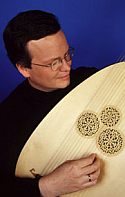
I’ve seen Tayler perform many times. So has anyone who regularly attends Philharmonia Baroque concerts, because Tayler is almost always out in front, with a huge archlute strapped to his shoulders. I say that I’ve seen him perform (rather than heard), because his lutes are intimate instruments, next to which a harpsichord sounds like a massive, howling beast.
But this afternoon, his lutes’ tones bloomed to fill the little Loper Chapel, an adjunct building to the First Congregational Church that is lamentably underused by early-music ensembles outside the festival period. The acoustics there were perfect for a solo lute concert. We could hear the zing of his fingers across the strings as he moved from position to position; we could hear each note of every little tossed-off ornament; and what we heard was just grand.
Typically, lute concerts can be ... well, there’s no delicate way to put this, except: Lute concerts can be dull. True, lute enthusiasts will wax poetic after solo events, while I’ve been snoring away in the back row, unable to hear the subtleties of the instrument, and bored to tears by straitlaced interpretations and the instrument’s monochrome timbre throughout the event.
Tayler overcame every one of those typical shortcomings. He played a set of pieces by John Dowland in which the clarity of counterpoint was astounding. He made a comment about the composer’s polyphonic capacities in prefatory remarks, and he brought out every nuance possible, rather than dwelling on the famous top-line melodies, such as the ubiquitous Lachrymae (Flow, my tears), which inspired Dowland’s rich settings.
Tayler also overcame the “monochrome” limitation of a solo lute concert, in two ways. His first technique was simple: He used two instruments: a Renaissance, crooknecked lute and a large archlute. He used the former for the Dowland set, and the latter for two other sets, one marked “Popular Music Ca. 1610” and one a set of Scottish music. He employed these folksy sounds as an excuse to play the lute in a novel way, wrapping his fingers around the strings and plucking upward, in imitation of harp technique (as he explained), in an effort to give a more “Scottish” twang. The approach was possibly questionable, musicologically speaking, but it was musically quite satisfying, and added yet another bit of tonal variety to the afternoon’s palette.
What a refreshing quaff that was. In just a few minutes, it’ll be time for another round across the street at Musica Pacifica’s own take on British music.
Greener Pastures (Jessica)
Championing the most iconic instrument of the early-music period is not an easy task. Add the sweltering heat of mid-June and the small, drywall design of the Loper Chapel, and soon what promised to be an intimate, lute-focused concert felt more restrictive and unsettled.This was an unexpected effect, given the concert’s impressive turnout, to say nothing of the work of lutenist David Tayler. Tayler’s mastery over the instrument etched a blend of Scottish sounds with more decor than the composers themselves might have intended. At other times, his flourishes and Spanish-flavored ornamentation insolently turned the instrumentalist from wandering troubadour to early music’s version of redneck minstrel. The pieces flirted with being too metallic, too thwacking, too twangy; they left the sonorous aftertaste one might have hearing a tuning tool as it slowly drops inside a piano: pretty, and robust, but a little odd.
Despite it all, Tayler created the intimate setting demanded of a postlunch lute concert and captivated his audience to such a degree that it willingly sat in closed, silent session while temperatures rose to the point of intrusion. And some other inviting surprises were in store, in interpretations of Fortune My Foe, Lachrimae, and other Dowland ditties.
Tayler’s battle between sensibility and sensation, old and modern, revered and popular, mirrored much of the early-music era itself: romance, expressiveness, and the adventure of the new muted by the unseen force of tradition. If his lute were a woman, “She was stronger alone; and her own good sense so well supported her, that her firmness was as unshaken, her appearance of cheerfulness as invariable, as, with regrets so poignant and so fresh, it was possible for them to be.”
Kicking Up Heels (Jonathan)
4:30 p.m.: To paraphrase, “If music be the drink of love, play on!”The next stop on our pub crawl was to sample more English stout alongside a swig or two of Irish whiskey and a single-malt scotch, all served up by the members of Musica Pacifica. I’ve praised Musica Pacifica before for its ability to inject fire into seemingly tired old repertoire. (See my review of their previous CD release.) In this afternoon’s concert, they instead brought this verve and a large dose of poignancy to music rarely heard in concert venues.
The program was one that focused on the British Isles, north and south. This fringe event took place in the Berkeley City Club, in a lovely room designed by Julia Morgan for social events, and, like Loper Chapel, an ideal, underutilized venue for Baroque music. The space had just two problems. First, there wasn’t enough room for the throngs of fans who flocked to hear the program. Second, it was miserably hot. The group was trying to balance wind instruments with keyboards, lute, and strings, and some inevitable intonation issues became noticeable in slow movements.
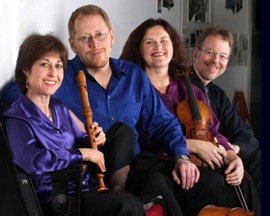
But for most of the program, who cared? The spirit was just right. Particularly effective were violinist Elizabeth Blumenstock’s arrangements of traditional Irish tunes. I’ve heard her do this sort of thing before, and was never quite won over; her playing always has plenty of grit in it, but there’s still typically something too studied in her approach to folksy music for it to be completely convincing. But for today’s program, she had an ensemble to work with. She composed contrapuntal lines to share with Robert Mealy on violin. Judith Linsenberg had the opportunity to toot along heterophonically on the gaggle of recorders that she brought with her. Peter Maund banged (gracefully) on all manner of percussion instruments. At times, they sounded like a bunch of drunken Irishmen — drunken Irishmen who play very, very well together.
Still, as toe-tapping as this all was, I had to duck out early because of the heat, so I missed their trip farther north for Blumenstock’s arrangement of Scottish traditional music, and for the more sober English music by Henry Purcell, his celebrated Three Parts Upon a Ground. I did manage to hear harpsichordist Charles Sherman’s poised interpretation of William Byrd’s La volta, a work with ferociously difficult left-hand passagework, which Sherman tossed off as if he’d been playing it his entire life. (Perhaps he has been.)
Musica Pacifica Packs ’Em In (Jessica)
“We’re just counting spaces to see how much room is left,” recorder player Judith Linsenberg shouted over the growing attendance line standing outside the Berkeley City Club venue where her ensemble was to play. Seating was so tight, in fact, that I, in an ill-advised decision that harkened back to my days in arts administration, stood to allow my neighbors the opportunity of enjoying their concert experience sur la place. As physiology slowly outweighed circumstance — shaking arms, broken concentration, downtrodden spirit — I was forced to leave. To those affected by my actions, and to the performers especially: Mea culpa.Despite the close quarters, Musica Pacifica took a delightful romp through the Irish, Scottish, and English dance and folk music collection that makes up their upcoming album, wittily titled Dancing in the Isles (set for release in October). This was another midafternoon concert whose programming instilled temporary amnesia from things like heat, proximity, and physiology. Dripping viols and powerful rhythmic precision guided the group on less a dance through the Isles and more a Viennese — though geographically and chronologically improbable — romantic traipse through the subtleties and sonorities of music revisited.
Some may have found Musica Pacifica’s penchant for broadminded recreation alarming, yet the group’s proud insistence on change, as if fighting a suffragette movement, credits them with deserved respect. With the flock of dance followers herded tightly into City Club on Saturday, Musica Pacifica’s soul train proved one to board.
Nightcap (Jonathan)
5:30 p.m.: No early-music festival is complete without an exhibition of instrument builders, publishers, ensembles, and recording companies. My prejudices always draw me to the harpsichords, so I rarely venture to the rest of the folks’ tables. Today was no exception, even though only two harpsichord builders attended this year (quite a reduction from previous years): Owen Daly of Salem, Oregon, and John Phillips of Berkeley.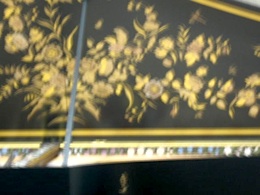
Phillips, the hometown builder and a major mover and shaker behind the scenes of the San Francisco Early Music Society, has been kept hopping by this festival. He supplied no fewer than four harpsichords for various concerts throughout the weekend, which I’ve been moving and tuning nonstop (which has been keeping me pretty busy, too!). Consequently he and I didn’t find a lot of time to sit down and chat. But I did manage to snap a photograph of him behind his exhibition instrument, a shiny new copy of a 1733 French harpsichord by François Blanchet. Phillip’s instruments are always visually pleasing, but Janine Johnson’s decorative work on this harpsichord was particularly striking, with a large floral lid decoration with staggeringly detailed flowers that practically glowed, owing to her perfectly smooth application of gold leaf.
Next to this elaborately beautiful instrument, Daly’s copy of Michael Mietke’s 1710 harpsichord looked positively sober, like a north-European corrective to the indulgence of its frou-frou French cousin. I had a chance to chat with Daly while he struggled to keep the new instrument in tune. (It was hot in that exhibition room, too.) He had decided to build this interesting harpsichord because of feeling dissatisfied with what he’d seen in other modern copies, and thought that he saw something actually unique in its basic design, as well as in its pedigree. Mietke is among the rare instrument-builders who connect directly to J.S. Bach — indeed, the famous Fifth Brandenburg Concerto (the one with the staggeringly long keyboard cadenza) may well have been written with that Berlin-based builder in mind.
This was one of the more interesting harpsichords I’ve played in a long time. It’s Italian in basic design, but with, as Daly put it, “a lot of heavy stuff inside.” I sat down at the instrument, intending to play for about two minutes, but I must have fiddled around with it for closer to 20. At the keyboard, the experience was like playing an organ, the sound distant from the keyboard, which took some getting used to. But the keyboards were wonderfully comfortable — addictive, even, as my self-indulgence reflected. And later, standing off to the side of the instrument and listening to somebody else play, I was struck by just how loud the instrument was, and how varied the individual ranks of quills were.
I was growing awfully fond of this harpsichord, and, as I started loading up my moving van with a harpsichord, organ, and viola da gamba, I offered to take it off Daly’s hands. He didn’t seem to find that suggestion particularly funny, since the instrument already belongs to a client in Boston.
Later on, I was kept busy moving instruments. My head had little room left for any more music. And there was even less room left in my van after loading all the keyboards that needed moving, so I had to strap a gamba into the passenger seat with its seatbelt. Where else can you see such a sight, outside an early-music festival? Ah, how I love Berkeley in even-numbered years!

